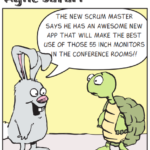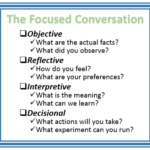Project retrospectives are challenging. I spoke a bit about this in lessons learned vs. project retrospectives. You might look at a merger, acquisition, implementation of a new ERP system, or even a major upgrade of an ERP or CRM system. These are non-reoccurring events. A retrospective of this type is quite different from a typical agile retrospective, primarily because on this type of project, people will change and the project will not repeat (the definition of a project is that it is a unique endeavor). At issue here is the fact that if the people will not be the same and the project does not reoccur – then they can’t come up with actions they will apply right away based on what they learned. Ideas for change often just end up in a spreadsheet, a book shelf, or some electronic tool. A big book of “lessons learned” that sits on the shelf gathering dust does not provide much, if any, value.
Project Management
Agile Safari – Best Agile Project Management Software
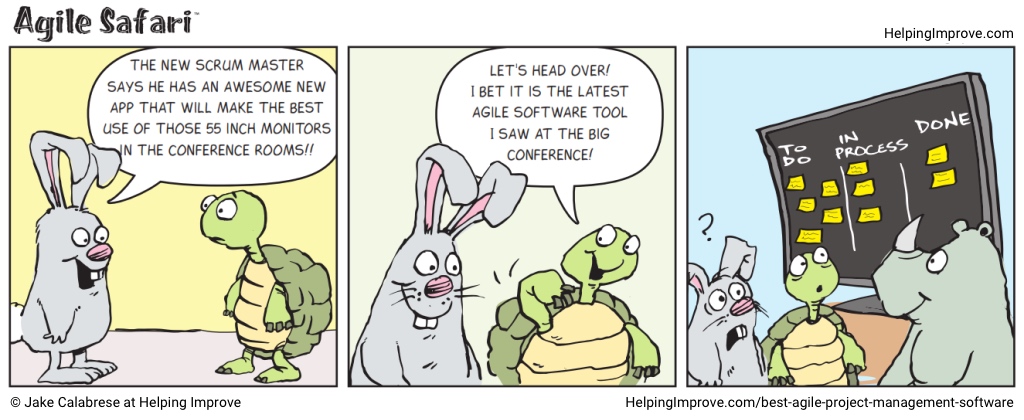
No, I don’t hate agile project management software — it can serve a purpose. At issue is if there is an actual purpose and if it is misused. Often the software stalls progress or worse, move us backwards. For any readers who are not familiar with agile or don’t work in software — the idea here is that instead of using the monitor to display some type of software tracking tool, the new scrum master just used sticky-notes and stuck them on the monitor. What is the simplest thing that works in your world?
Agile Safari – What’s Not Being Said?
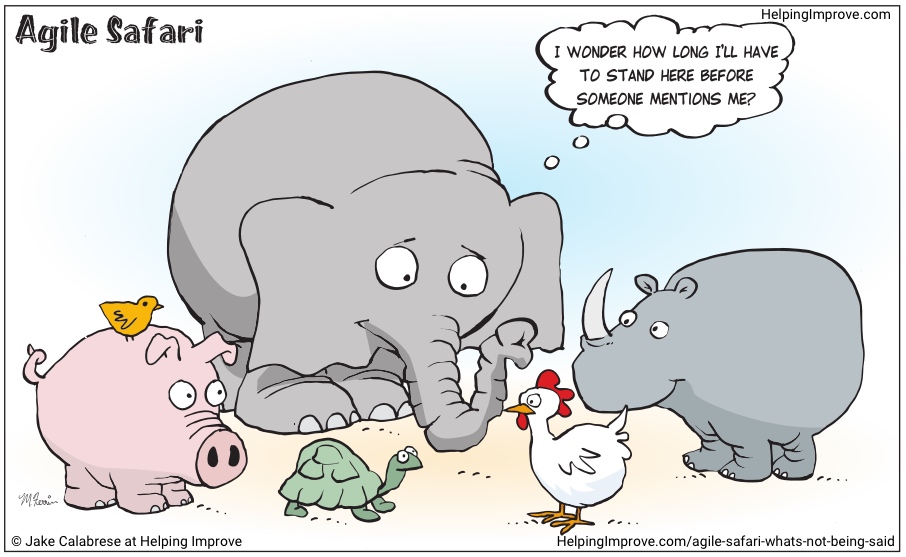
Have you been in a situation where no one would bring up the problem that everyone knew was “in the room?” I’d guess that everyone has been there. So often, we don’t bring up the “elephant in the room.” For anyone who has not heard of this, the elephant in the room is a saying for the real or obvious truth that is not being addressed. Given an elephant in a room would be hard to miss, when people ignore it, they are typically pretending it is not there.
Facilitating with The Focused Conversation
I was presenting Building Antifragile Relationships and Teams at Santa Barbara Agile recently and as we worked on ideas for a conflict protocol, we started discussing the common theme of “facts vs. feelings”. I’ll point out that there was not a hard-line view in the group as to one way or another, but it came up and opened up a nice discussion on the topic.
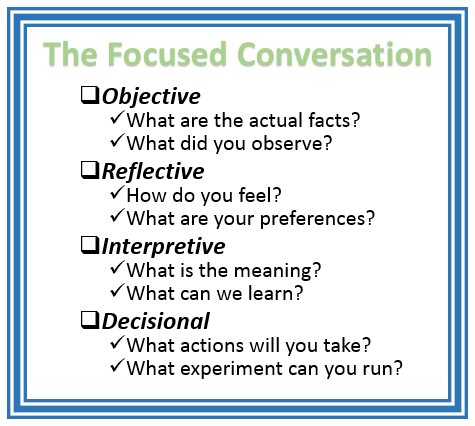
I mentioned The Focused Conversation as a great tool you can use to help structure a conversation. Focused Conversations include four important categories of questions — objective, reflective, interpretive, and decision focused questions. The acronym ORID is sometimes used to describe The Focused Conversation.
The structure also provides a way to hear all of the voices that need to be heard within the group or team. You might even use this as part of an agile retrospective. Using the tool is another way to build antifragile relationships in teams and organizations.
Be Better, Don’t Limit Yourself to Best Practices
We hear a lot about best practices. We talk a lot about them. Many organizations are of the opinion that if they can identify the best practice, they are set. Of course, that thinking can be limiting in a number of ways. We need to be better, not best.
Limiting Yourself with Best Practices
Googling “best practice definition” gives you “commercial or professional procedures that are accepted or prescribed as being correct or most effective.”
Wikipedia says : “A best practice is a method or technique that has consistently shown results superior to those achieved with other means, and that is used as a benchmark. In addition, a “best” practice can evolve to become better as improvements are discovered. Best practice is considered by some as a business buzzword, used to describe the process of developing and following a standard way of doing things that multiple organizations can use.”
Notice in the Wikipedia definition they add the idea that they can evolve to become better. This gets to the root of what we need to be doing.
Bad Standard: Plus-Minus-Delta Agile Retrospectives
Many people dislike the 3 question, plus-minus-delta retrospective. I am one of them. The plus-minus-delta agile retrospective leads to many problems. I say it was never the “standard” in the title, so why are so many people confused? Or…am I the one confused?
While co-coaching recently, the other coach and I had a brief exchange about how the “standard” agile retrospective was not good. I was a little confused, since while I certainly do not always use ‘the standard’ or baseline agile retrospective, there is value to it — at least I thought so? The baseline retrospective I employ is a solid method to teach people how to do an agile retrospective. I asked a few more questions and realized that while we were both using the term “standard retrospective,” we had different definitions of the term.
Cursing Your Vision Statement
I was coaching someone a while back and asked them to tell me what their vision statement: what motivated him? When I heard the answer, I was not moved. What I heard was boring. I knew this person had passion for what he did. What happened to it?
If I ask you to tell me why you do what you do, and you are not jumping up and down a bit, getting a bit fired up, I don’t buy your passion! Here are some ideas to find the passion in your vision statement. They may not be for everyone, but I know they have helped some people already, so I wanted to share.
Improving Yourself with StrengthsFinder 2.0
I am often asked by folks I’m coaching for ideas of assessments they can take to help them grow.
I’m working on a few articles about different types of assessments and improving yourself (subscribe if you are interested in being notified). I thought I’d take some time to explain some of insights I got from taking the StrengthsFinder® 2.0 assessment a while back, as well as explain what it is and how to take it. This is the first of three articles on assessments. The other two will cover MBTI® and The Leadership Circle Profile® . All three are very different in a number of ways, which I will discuss in those articles.
Agile and Agility are about people, learning, and collaborating – a foundational part being able to collaborating and learning with others is personal mastery.
Lessons-Learned vs Project Retrospectives
I wrote about agile team retrospectives in a recent article and find that the term retrospective can be used in many different ways. I’ve heard people ask, “Did you just change the name from lessons-learned to retrospective?” Although there are similarities, there are some key differences. Let’s review a few types and consider the issues with most lessons-learned meeting.
Release and Project Retrospectives
While agile team retrospectives have a team focus on celebrating, learning, and improving their relationship on a regular basis, there are other types of retrospectives.
Agile Retrospective Resources
There is a lot of information out there are agile retrospectives. I have a number of articles on them and there are plenty of places with information including blogs, websites, and books.
My Articles About Agile Retrospectives
I’m working on a series about retrospectives, and have included a list of articles that are already written as well as some of the future articles. If you are interested in subscribing to get notified of the next post, please subscribe via email.


